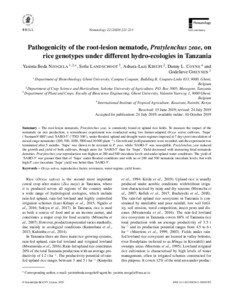| dc.contributor.author | Nzogela, Y.B. |
| dc.contributor.author | Landschoot, S. |
| dc.contributor.author | Kihupi, A.L. |
| dc.contributor.author | Coyne, D.L. |
| dc.contributor.author | Gheysen, G. |
| dc.date.accessioned | 2022-07-29T09:27:30Z |
| dc.date.available | 2022-07-29T09:27:30Z |
| dc.date.issued | 2020 |
| dc.identifier.citation | Nzogela, Y.B., Landschoot, S., Kihupi, A.L., Coyne, D.L. & Gheysen, G. (2020). Pathogenicity of the root-lesion nematode, Pratylenchus zeae, on rice genotypes under different hydro-ecologies in Tanzania. Nematology, 22(2), 221-233. |
| dc.identifier.issn | 1388-5545 |
| dc.identifier.uri | https://hdl.handle.net/20.500.12478/7589 |
| dc.description.abstract | The root-lesion nematode, Pratylenchus zeae, is commonly found in upland rice fields. To measure the impact of the nematode on rice production, a screenhouse experiment was conducted using two farmer-adapted Oryza sativa cultivars, ‘Supa’ (‘SurinamV-880’) and ‘SARO-5’ (‘TXD 306’), under flooded, upland and drought water regimes imposed at 7 days post-inoculation of mixed-stage nematodes (200, 500, 1000, 3000 and 10 000 plant−1). Growth and yield parameters were recorded, and the experiment was terminated after 5 months. ‘Supa’ was shown to be resistant to P. zeae, while ‘SARO-5’ was susceptible. Pratylenchus zeae reduced the growth and yield of both cultivars, though more for ‘SARO-5’ than for ‘Supa’. Yield decreased with increasing final nematode densities. Pratylenchus zeae reproduction was highest at 200 and 500 inoculum levels and under upland water conditions. The yield of ‘SARO-5’ was greater than that of ‘Supa’ under flooded conditions and with no or 200 and 500 nematode inoculum levels, but with high P. zeae inoculum ‘Supa’ yield was better than ‘SARO-5’. |
| dc.format.extent | 221-233 |
| dc.language.iso | en |
| dc.subject | Rice |
| dc.subject | Oryza Sativa |
| dc.subject | Reproduction |
| dc.subject | Resistance To Injurious Factors |
| dc.subject | Yields |
| dc.subject | Yield Losses |
| dc.subject | Tanzania |
| dc.title | Pathogenicity of the root-lesion nematode, pratylenchus zeae, on rice genotypes under different hydro-ecologies in Tanzania |
| dc.type | Journal Article |
| cg.contributor.crp | Roots, Tubers and Bananas |
| cg.contributor.affiliation | Ghent University |
| cg.contributor.affiliation | Sokoine University of Agriculture |
| cg.contributor.affiliation | International Institute of Tropical Agriculture |
| cg.coverage.region | Africa |
| cg.coverage.region | East Africa |
| cg.coverage.country | Tanzania |
| cg.coverage.hub | Eastern Africa Hub |
| cg.researchtheme | Natural Resource Management |
| cg.identifier.bibtexciteid | NZOGELA:2020 |
| cg.isijournal | ISI Journal |
| cg.authorship.types | CGIAR and developing country institute |
| cg.iitasubject | Agronomy |
| cg.iitasubject | Disease Control |
| cg.iitasubject | Farming Systems |
| cg.iitasubject | Food Security |
| cg.iitasubject | Natural Resource Management |
| cg.iitasubject | Plant Production |
| cg.journal | Nematology |
| cg.notes | Published online: 10 October 2019 |
| cg.accessibilitystatus | Limited Access |
| cg.reviewstatus | Peer Review |
| cg.usagerightslicense | Copyrighted; all rights reserved |
| cg.targetaudience | Scientists |
| cg.identifier.doi | https://dx.doi.org/10.1163/15685411-00003302 |
| cg.iitaauthor.identifier | Daniel Coyne: 0000-0002-2030-6328 |
| cg.futureupdate.required | No |
| cg.identifier.issue | 2 |
| cg.identifier.volume | 22 |

